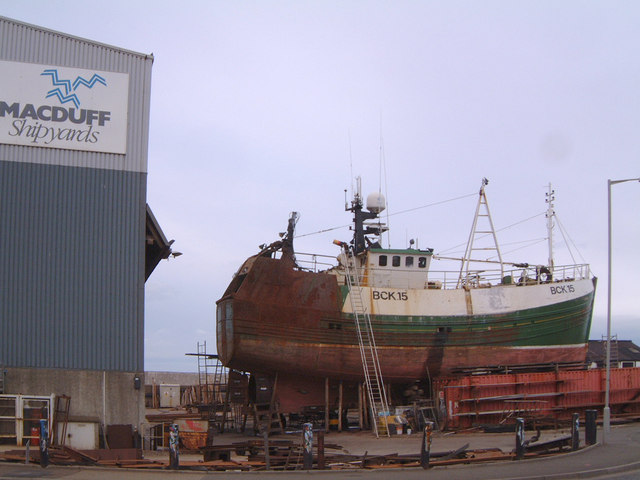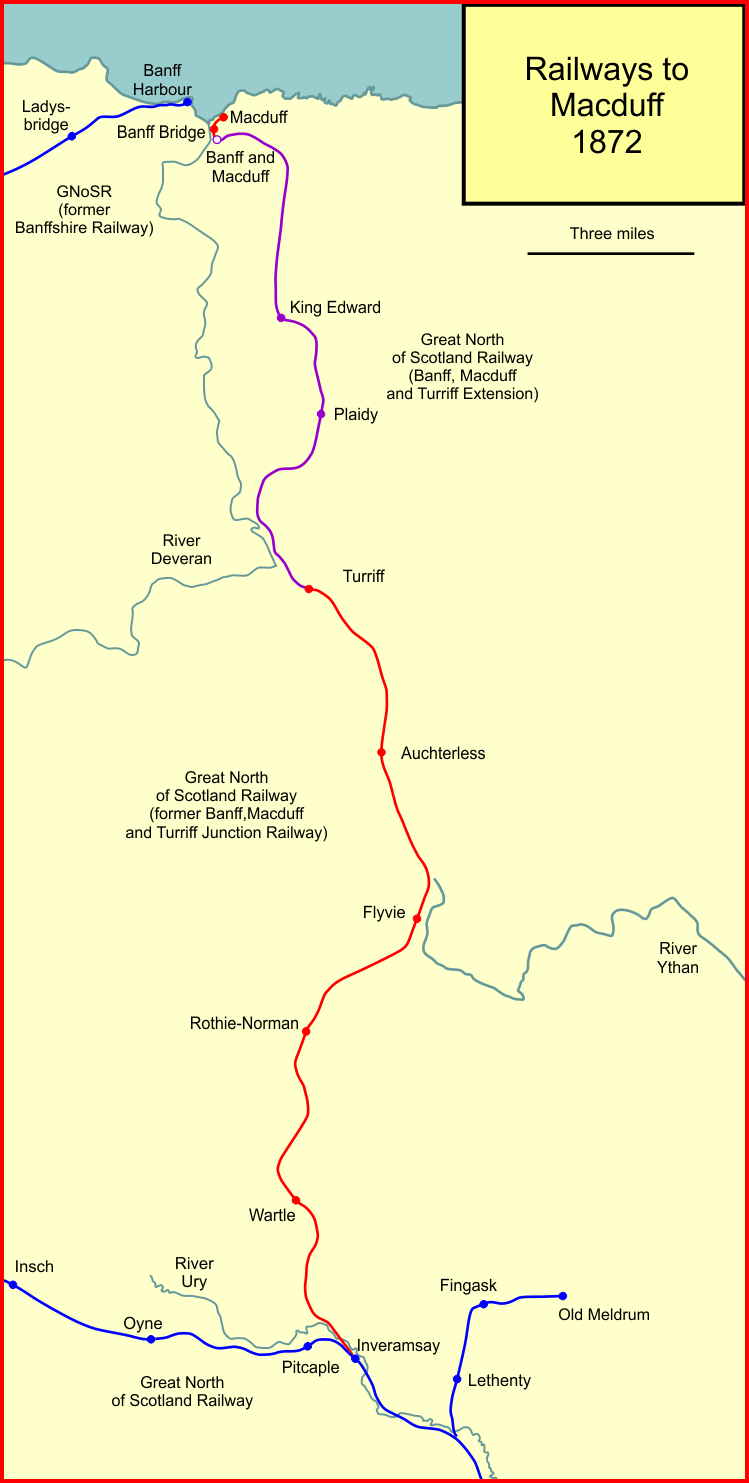|
Macduff (Banff) Railway Station
Macduff (Banff) railway station served the town of Macduff, Aberdeenshire, Scotland, from 1860 to 1872 on the Banff, Macduff and Turriff Junction Railway. History The station opened as Banff and Macduff on 4 June 1860 by the Great North of Scotland Railway The Great North of Scotland Railway (GNSR) was one of the two smallest of the five major Scottish railway companies prior to the 1923 Grouping, operating in the north-east of the country. Formed in 1845, it carried its first passengers the fr .... To the south was the goods yard and to the north was a locomotive shed. The station's name was changed to Macduff (Banff) in 1866. The location wasn't ideal because it was situated a mile away from Macduff so it closed on 1 July 1872. References External links Disused railway stations in Aberdeenshire Former Great North of Scotland Railway stations Railway stations in Great Britain opened in 1860 Railway stations in Great Britain closed in 1872 1860 establis ... [...More Info...] [...Related Items...] OR: [Wikipedia] [Google] [Baidu] |
Macduff, Aberdeenshire
Macduff ( gd, An Dùn) is a town in the Banff and Buchan area of Aberdeenshire, Scotland. It is situated on Banff Bay and faces the town of Banff across the estuary of the River Deveron. Macduff is a former burgh and was the last place in the United Kingdom where deep-water wooden fishing boats were built. History The settlement of Doune (from the Scottish Gaelic , "hill fort") was purchased in 1733 by William Duff, who became the first Earl Fife. In 1760, James Duff, the second earl, built a harbour there and in 1783 succeeded in raising Doune to the status of a burgh of barony, renaming it " Macduff" after his supposed ancestor. The 2nd Earl Fife appointed his factor, William Rose, as the first Provost of Macduff in 1783. The town celebrated its bicentenary in 1983, and the signs erected in that year still stand on the main approaches to the town (most visibly, a large sign next to the Banff Bridge on the Macduff side). Banff and Macduff are separated by the valley of th ... [...More Info...] [...Related Items...] OR: [Wikipedia] [Google] [Baidu] |
Aberdeenshire
Aberdeenshire ( sco, Aiberdeenshire; gd, Siorrachd Obar Dheathain) is one of the 32 Subdivisions of Scotland#council areas of Scotland, council areas of Scotland. It takes its name from the County of Aberdeen which has substantially different boundaries. The Aberdeenshire Council area includes all of the area of the Counties of Scotland, historic counties of Aberdeenshire and Kincardineshire (except the area making up the City of Aberdeen), as well as part of Banffshire. The county boundaries are officially used for a few purposes, namely land registration and Lieutenancy areas of Scotland, lieutenancy. Aberdeenshire Council is headquartered at Woodhill House, in Aberdeen, making it the only Scottish council whose headquarters are located outside its jurisdiction. Aberdeen itself forms a different council area (Aberdeen City). Aberdeenshire borders onto Angus, Scotland, Angus and Perth and Kinross to the south, Highland (council area), Highland and Moray to the west and Aber ... [...More Info...] [...Related Items...] OR: [Wikipedia] [Google] [Baidu] |
Great North Of Scotland Railway
The Great North of Scotland Railway (GNSR) was one of the two smallest of the five major Scottish railway companies prior to the 1923 Grouping, operating in the north-east of the country. Formed in 1845, it carried its first passengers the from Kittybrewster, in Aberdeen, to Huntly on 20 September 1854. By 1867 it owned of line and operated over a further . The early expansion was followed by a period of forced economy, but in the 1880s the railway was refurbished, express services began to run and by the end of that decade there was a suburban service in Aberdeen. The railway operated its main line between Aberdeen and and two routes west to , connections could be made at both Keith and Elgin for Highland Railway services to Inverness. There were other junctions with the Highland Railway at and , and at Aberdeen connections for journeys south over the Caledonian and North British Railways. Its eventual area encompassed the three Scottish counties of Aberdeenshire, Banffs ... [...More Info...] [...Related Items...] OR: [Wikipedia] [Google] [Baidu] |
Banff, Macduff And Turriff Junction Railway
The Banff, Macduff and Turriff Junction Railway was a railway company that connected the Aberdeenshire town of Turriff with the main line of the Great North of Scotland Railway (GNoSR) at Inveramsay. It had earlier been intended to reach Macduff, but shortage of finance forced curtailment. It opened its line in 1857. A separate company, the Banff, Macduff and Turriff Extension Railway, was formed to build an extension to Macduff. There was a road bridge connecting Macduff with Banff, crossing the River Deveron, and it was intended that both towns would be served by the railway’s terminus. The Extension Railway opened in 1860, but its terminus was some distance short of Macduff and of the bridge to Banff. Both railways were absorbed by the Great North of Scotland Railway in 1866, and the line was extended by the GNoSR to a new station in 1872, with an intermediate station at the river bridge. The companies and the branch line were never commercially successful. In 1951 the li ... [...More Info...] [...Related Items...] OR: [Wikipedia] [Google] [Baidu] |
Banff, Macduff And Turriff Extension Railway
The Banff, Macduff and Turriff Junction Railway was a railway company that connected the Aberdeenshire town of Turriff with the main line of the Great North of Scotland Railway (GNoSR) at Inveramsay. It had earlier been intended to reach Macduff, but shortage of finance forced curtailment. It opened its line in 1857. A separate company, the Banff, Macduff and Turriff Extension Railway, was formed to build an extension to Macduff. There was a road bridge connecting Macduff with Banff, crossing the River Deveron, and it was intended that both towns would be served by the railway’s terminus. The Extension Railway opened in 1860, but its terminus was some distance short of Macduff and of the bridge to Banff. Both railways were absorbed by the Great North of Scotland Railway in 1866, and the line was extended by the GNoSR to a new station in 1872, with an intermediate station at the river bridge. The companies and the branch line were never commercially successful. In 1951 the li ... [...More Info...] [...Related Items...] OR: [Wikipedia] [Google] [Baidu] |
Former Great North Of Scotland Railway Stations
A former is an object, such as a template, gauge or cutting die, which is used to form something such as a boat's hull. Typically, a former gives shape to a structure that may have complex curvature. A former may become an integral part of the finished structure, as in an aircraft fuselage, or it may be removable, being using in the construction process and then discarded or re-used. Aircraft formers Formers are used in the construction of aircraft fuselage, of which a typical fuselage has a series from the nose to the empennage, typically perpendicular to the longitudinal axis of the aircraft. The primary purpose of formers is to establish the shape of the fuselage and reduce the column length of stringers to prevent instability. Formers are typically attached to longerons, which support the skin of the aircraft. The "former-and-longeron" technique (also called stations and stringers) was adopted from boat construction, and was typical of light aircraft built until the ... [...More Info...] [...Related Items...] OR: [Wikipedia] [Google] [Baidu] |
Railway Stations In Great Britain Opened In 1860
Rail transport (also known as train transport) is a means of transport that transfers passengers and goods on wheeled vehicles running on rails, which are incorporated in tracks. In contrast to road transport, where the vehicles run on a prepared flat surface, rail vehicles (rolling stock) are directionally guided by the tracks on which they run. Tracks usually consist of steel rails, installed on sleepers (ties) set in ballast, on which the rolling stock, usually fitted with metal wheels, moves. Other variations are also possible, such as "slab track", in which the rails are fastened to a concrete foundation resting on a prepared subsurface. Rolling stock in a rail transport system generally encounters lower frictional resistance than rubber-tyred road vehicles, so passenger and freight cars (carriages and wagons) can be coupled into longer trains. The operation is carried out by a railway company, providing transport between train stations or freight customer facil ... [...More Info...] [...Related Items...] OR: [Wikipedia] [Google] [Baidu] |
Railway Stations In Great Britain Closed In 1872
Rail transport (also known as train transport) is a means of transport that transfers passengers and goods on wheeled vehicles running on rails, which are incorporated in tracks. In contrast to road transport, where the vehicles run on a prepared flat surface, rail vehicles (rolling stock) are directionally guided by the tracks on which they run. Tracks usually consist of steel rails, installed on sleepers (ties) set in ballast, on which the rolling stock, usually fitted with metal wheels, moves. Other variations are also possible, such as "slab track", in which the rails are fastened to a concrete foundation resting on a prepared subsurface. Rolling stock in a rail transport system generally encounters lower frictional resistance than rubber-tyred road vehicles, so passenger and freight cars (carriages and wagons) can be coupled into longer trains. The operation is carried out by a railway company, providing transport between train stations or freight customer faciliti ... [...More Info...] [...Related Items...] OR: [Wikipedia] [Google] [Baidu] |
1860 Establishments In Scotland
Year 186 ( CLXXXVI) was a common year starting on Saturday (link will display the full calendar) of the Julian calendar. At the time, it was known as the Year of the Consulship of Aurelius and Glabrio (or, less frequently, year 939 '' Ab urbe condita''). The denomination 186 for this year has been used since the early medieval period, when the Anno Domini calendar era became the prevalent method in Europe for naming years. Events By place Roman Empire * Peasants in Gaul stage an anti-tax uprising under Maternus. * Roman governor Pertinax escapes an assassination attempt, by British usurpers. New Zealand * The Hatepe volcanic eruption extends Lake Taupō and makes skies red across the world. However, recent radiocarbon dating by R. Sparks has put the date at 233 AD ± 13 (95% confidence). Births * Ma Liang, Chinese official of the Shu Han state (d. 222) Deaths * April 21 – Apollonius the Apologist, Christian martyr * Bian Zhang, Chinese official an ... [...More Info...] [...Related Items...] OR: [Wikipedia] [Google] [Baidu] |






